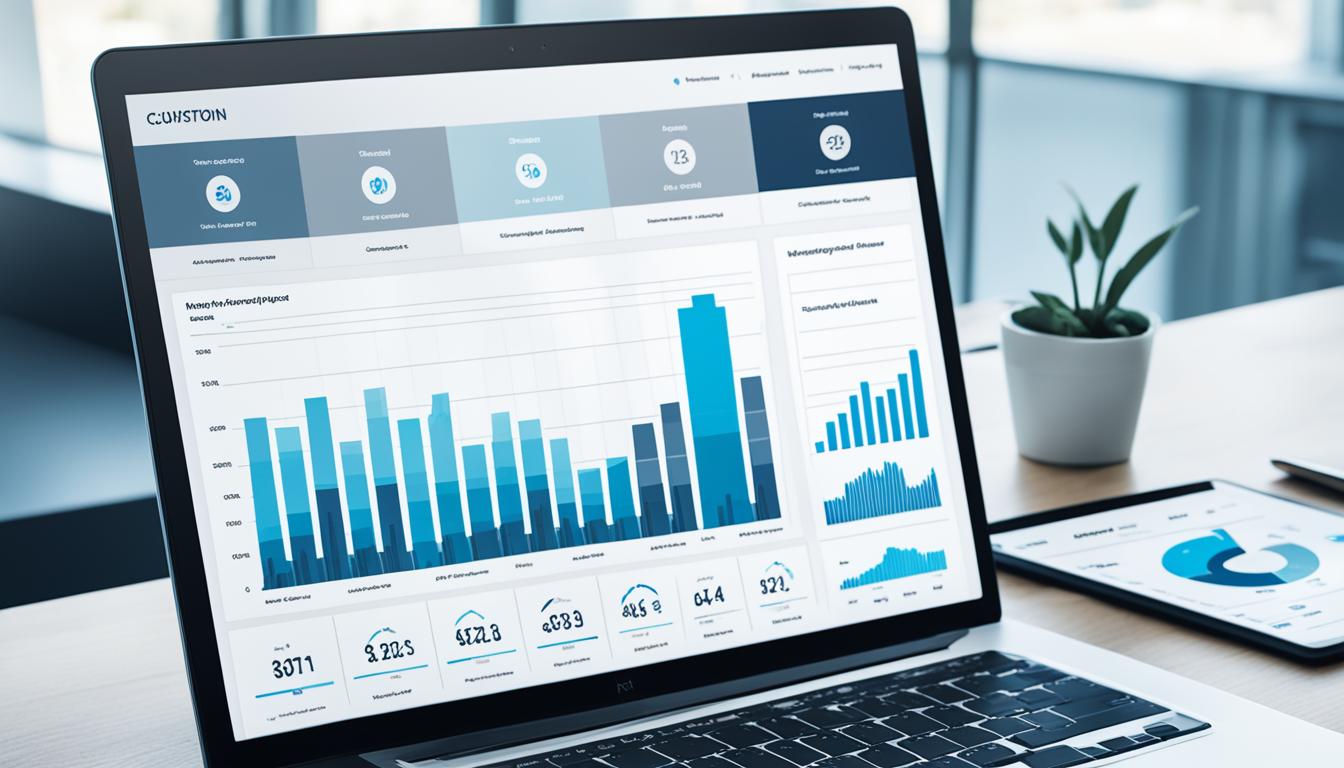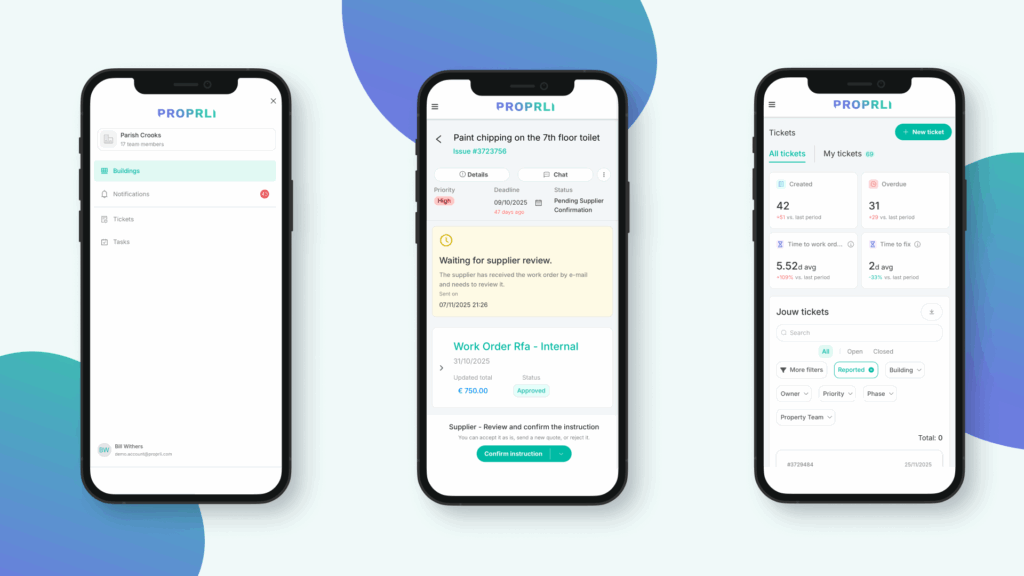Managing large-scale property portfolios can be daunting without effective tools. A real estate dashboard serves as a centralized platform. It allows technical property managers and asset managers to manage all facets of property management and development effortlessly. By amalgamating operational and financial data, it offers insights into the current state and performance of managed properties.
The adoption of a comprehensive real estate dashboard simplifies property management. It moves beyond the limitations of traditional spreadsheets. By highlighting trends and applying predictive analytics to understand market demands, managers are empowered to make informed decisions. This modern method employs data-driven insights, which are pivotal for achieving management goals with efficiency.
Key Takeaways
- Real estate dashboards consolidate operational and financial data.
- These dashboards provide real-time performance visualization.
- Facilitate trend identification and market demand predictions.
- Promote informed decision-making without traditional spreadsheet complexities.
- Enhances efficiency in property and asset management.
Understanding the Need for Specialized Real Estate Dashboards
Specialized real estate dashboards are crucial for property and asset managers. They tackle a host of challenges, including operational bottlenecks and the need for precise trend analysis and market forecasts.
Challenges in Property Management
The management of real estate properties entails navigating through immense data volumes and various factors. Often, the performance in technical management is compromised by the scattered nature of these data sources. This reality complicates obtaining a holistic view of a property’s performance. Additionally, traditional spreadsheet methods fall short in addressing the intricate demands of contemporary property management.
Need for Streamlined Data Representation
That’s where the utility of real estate data visualization and automated tracking emerges. Through the adoption of advanced visualization platforms like Power BI, specialized dashboards offer a unified snapshot of critical indicators. Metrics such as occupancy levels, maintenance expenditures, and tenant contentment are easily monitored. This evolution towards a data-centric management approach enhances agility and clarity, thereby empowering managers to attain operational superiority and foster strategic expansion.
What is a Real Estate Dashboard?
A real estate dashboard is a dynamic tool that integrates multiple data sources. It helps property and asset managers understand their portfolios’ performance. With its interactive real estate reporting capabilities, it simplifies complex information, allowing simultaneous monitoring of different property management areas.
This tool makes critical metrics like financial results, occupancy rates, and tenant demographics easily understandable. Customizable widgets and displays spotlight crucial data. This aids in both daily operations and strategic investment planning.
These dashboards also act as a complete property analytics platform. They offer real-time updates and integrate with data systems effortlessly. Such a seamless integration aids in spotting trends and performing predictive analysis, meeting market demands.
Using interactive real estate reporting, managers streamline portfolio management. Emphasizing key metrics and visual insights leads to better decisions. This approach propels property management and investment endeavors to success.
Key Features of an Effective Real Estate Dashboard
An effective real estate dashboard stands out by presenting vital features. These allow property and asset managers to make informed decisions. Key features support strong data management and provide actionable insights. This fosters both efficiency and strategic growth in the field.
Real-time Data Updates
One of the most critical features of a successful real estate dashboard is real-time data updates. This ensures managers are always aware of the latest property trends and developments. With access to real-time real estate performance metrics, managers can quickly adjust their strategies. This adaptability enhances the dynamic optimization of their management efforts.
Customizable Reports
Customizable reports are vital to meet diverse management objectives. They offer insights tailored to the specific needs and goals of each manager. By emphasizing key data points and trends, these customized reports increase the utility and relevance of real estate dashboard solutions. Furthermore, they permit managers to adopt a more focused approach in property management.
Integration with Multiple Data Sources
Effective integration with numerous data sources is crucial for a comprehensive analysis. Such a feature ensures a holistic view of property performance. A sophisticated property analytics platform doesn’t just compile data—it also refines and organizes this information. Consequently, it creates interactive reports that are essential in formulating strategies and enhancing efficiency.
- Real-time data updates: Immediate insights into real estate performance metrics.
- Customizable reports: Tailored insights adapted to specific management goals.
- Integration with multiple data sources: Comprehensive datasets for holistic property analysis.
Benefits of Using a Real Estate Dashboard
A real estate dashboard collects data from entire property portfolios into one place. It’s invaluable for property and asset managers. It displays crucial information centrally, enabling informed and efficient decisions. This culminates in a better grasp of market insights, helping predict trends and pinpoint improvements.
Its key advantage is revealing cost-saving areas. Dashboards streamline operations, boosting efficiency and accuracy. They provide deep market insights, tracking financial health, occupancy, and tenant satisfaction. These factors are vital for enhancing property management.
Moreover, these dashboards aid in strategic planning through data-driven insights. They help identify investment opportunities and keep tabs on developments. Access to up-to-the-minute data lets managers adjust strategies swiftly. This keeps them competitive in the fast-paced real estate world.
In summary, a real estate dashboard removes management complexity. It transforms vast amounts of data into clear, actionable insights. It not only makes management smoother but also supports reaching financial objectives through effective property and asset management.
How to Choose the Right Real Estate Dashboard Solutions
Finding the ultimate real estate dashboard solutions is key for successful property management and goal achievement. Here’s what to consider when selecting:
Assess Your Needs
Evaluate your current software requirements for property management. Pinpoint the necessary data analytics and functionalities to serve your organization. This step guarantees the selection of real estate dashboard solutions tailored to your needs.
Check for Scalability
The scalability of a solution is crucial. Ensure that the real estate dashboard solution can grow with your business. It should handle more data and complex tracking as your portfolio enlarges.
Look for Ease of Use
Choosing user-friendly software is imperative. It should be easy to adopt and require minimal training. An intuitive interface guarantees efficient utilization of automated real estate tracking by your team.
Important Real Estate Performance Metrics to Track
Tracking real estate performance metrics is essential for managing properties effectively. The right metrics offer a clear overview, helping managers to make informed choices. This boosts operational efficiency and increases profits. A good property analytics platform is crucial for keeping an eye on these metrics.
Occupancy Rates
Occupancy rates are crucial for measuring property success. High rates indicate strong demand and effective management. Keeping tabs on this metric sheds light on how well the property is used and points out areas for improvement.
Tenant Satisfaction Scores
Tenant satisfaction is vital as it shows how happy tenants are with their living conditions and the services provided. Better satisfaction leads to higher retention and fewer vacancies. Property managers can use analytics tools to collect and assess tenant feedback, improving satisfaction levels.
Maintenance Costs
Maintenance costs are a key factor in real estate profitability. By tracking these expenses, managers can ensure resources are used wisely. Analyzing these costs reveals trends and areas where spending can be reduced. This leads to enhanced financial management.
Best Practices for Data Visualization in Real Estate
In real estate, presenting complex information clearly is critical. Professionals need to follow important practices for effective interactive reporting. These practices help make the presentation both understandable and actionable.
Use of Clear and Simple Charts
Real estate data visualization benefits from straightforward, easily interpreted charts. Bar charts, line graphs, and pie charts can show trends, compare metrics, and spotlight important data efficiently. It’s essential to avoid complicating charts with unnecessary details. Make sure labels and legends are easy to read and straightforward.
Consistency in Data Representation
Maintaining consistency across reports is vital. Stakeholders can quickly understand and compare information with uniform colors, fonts, and styles. This consistency in data structures and visual presentation fosters familiarity. It also makes using interactive reports more intuitive and effective.
Adhering to these guidelines, real estate experts can better deliver insights. This leads to more informed decisions and enhances property management and investment results.
Implementing a Real Estate Dashboard in Your Organization
Incorporating a real estate dashboard streamlines operations and enhances technical management. The setup process involves configuring the dashboard with necessary metrics and features suited to your needs. It also includes training your team for full capability leverage and optimization.
Setting Up the Dashboard
Initiating the setup of your real estate dashboard is paramount. Start by merging your property management software to blend data from diverse sources into one platform. Customize it with vital performance indicators that mirror your organizational objectives. Include crucial metrics like occupancy rates, maintenance expenses, and tenant satisfaction for a personal and effective dashboard. This leads to improved management performance.
Training Your Team
Training your team is vital for reaping your real estate dashboard’s full benefits. Begin with in-depth onboarding to explain the basic and advanced functionalities. Teach them to understand various metrics, create tailored reports, and apply predictive analytics for better choices. Regular training updates on new functionalities and practices ensure ongoing performance excellence.
| Implementation Steps | Details |
|---|---|
| Setting Up the Dashboard | Integrate property management software, customize KPIs, ensure comprehensive data aggregation |
| Training Your Team | Conduct onboarding sessions, cover dashboard functionalities, highlight interpretation of metrics |
Real estate dashboard: Visualize your technical management performance.
In the real estate sector’s dynamic landscape, a real estate dashboard is crucial. It offers a visual representation of technical performance, integrating vast property data. These insights are invaluable for property and asset managers, aiding in swift decision-making. An effective property analytics platform enables understanding market trends and dynamics easily.
The great benefit of a real estate dashboard is its simplified data management. Gone are the days of sifting through endless spreadsheets. Managers have all vital information at their fingertips, presented through an easy-to-use interface. This centralization improves insight into the real estate market, fostering strategic operations and efficiency.
Dashboards also offer a detailed look at key performance indicators like occupancy rates and tenant satisfaction. Using a property analytics platform, managers can refine operations. They pinpoint improvement areas and predict market shifts, boosting their market position.
A modern real estate dashboard integrates data from diverse systems effortlessly. This comprehensive perspective is key to evaluating asset health and performance. It drives strategic decisions, enhancing investment returns. Embracing this technology is vital for success in today’s fast-paced real estate market.
| Feature | Benefit |
|---|---|
| Data Consolidation | Unifies all property data for a comprehensive view. |
| Real-Time Insights | Enables quick decision-making with up-to-date information. |
| Trend Identification | Helps predict market movements and inform strategies. |
| Operational Efficiency | Simplifies reporting processes, saving time and resources. |
| Data Analysis | Facilitates a thorough understanding of performance metrics. |
Common Pitfalls and How to Avoid Them
When introducing real estate dashboard solutions, it’s critical to avoid common mistakes. Overloading the dashboard with too many metrics can lead to confusion. A cluttered interface makes it hard to spot important data. Focus on metrics that reflect key performance indicators and business goals. This approach simplifies data analysis and enhances decision-making.
Another mistake is not updating the system regularly. Real estate dashboards rely on current data for accuracy. Without frequent updates, the information becomes outdated, which can skew business decisions. Regular maintenance and data review are essential. They keep the dashboard accurate and operational, aiding in more informed decision-making.
Ignoring the importance of staff training is another oversight. Even the most innovative dashboards need knowledgeable users. Effective training empowers team members to leverage all features, boosting efficiency. This investment in training ensures that staff can interpret data accurately, leading to better strategic decisions. By avoiding these pitfalls, firms can maximize their dashboard’s value, ultimately enhancing performance and strategic outcomes.
Case Studies: Successful Use of Real Estate Dashboards
In today’s quickly changing real estate landscape, utilizing real estate dashboards effectively can greatly enhance technical management and operational results. The following cases illustrate how different organizations have used real estate metrics to improve their decision-making process and customer happiness.
Improving Decision-Making Efficiency
A leading property management company adopted a real estate dashboard to refine their data analysis and report generation. This move centralized all pertinent data onto a singular platform. It allowed for real-time tracking and evaluation of real estate metrics. Consequently, the management acquired vital insights that fostered quicker, well-informed decisions.
| Before Dashboard Implementation | After Dashboard Implementation |
|---|---|
| Data scattered across multiple systems | Centralized data consolidation |
| Manual report generation | Automated and real-time reporting |
| Delayed decision-making | Quick, data-driven decisions |
Enhance Customer Satisfaction
A major real estate firm utilized its dashboard to boost tenant satisfaction by focusing on key performance indicators, including tenant feedback and maintenance timeliness. Thanks to real-time dashboard analytics, the company swiftly pinpointed tenant issues and resolved them. This led to higher satisfaction scores and reduced tenant turnover.
| Challenge | Solution | Outcome |
|---|---|---|
| Low tenant satisfaction | Real-time analytics on tenant feedback | Improved tenant satisfaction scores |
| Delayed maintenance responses | Quick identification of service issues | Faster resolution of maintenance requests |
| High tenant turnover | Targeted improvements in service delivery | Increased tenant retention |
Future Trends in Real Estate Dashboard Technology
The evolving landscape of real estate dashboard technology is leading to transformative advancements. Innovative trends are poised to enhance the capabilities of property analytics platforms. In addition, real estate data visualization tools will significantly benefit.
AI and Machine Learning Integrations
AI and machine learning are revolutionizing the interpretation and processing of data. These technologies automate data analysis. As a result, real estate data visualization now offers deeper insights and predictive analytics. This enables property and asset managers to spot patterns and trends without extensive manual analysis.
Advanced Predictive Analytics
Advanced predictive analytics is shaping the future of property analytics platforms. These tools use historical and real-time data to predict market behaviors. This assists in making informed investment decisions and crafting property management strategies. Predictive models increase forecast accuracy, allowing managers to better anticipate changes and adjust their operations.
These trends underline the significant transformation underway in the real estate industry. They also highlight the important role real estate data visualization and property analytics platforms will play. Such tools are essential for future-proofing property and asset management practices.
Conclusion
In today’s fast-paced real estate world, leveraging a real estate dashboard is crucial. It boosts technical management performance. By merging operational and financial data, these dashboards provide vital insights in real-time. This allows for a comprehensive view of both property conditions and market changes.
Moreover, this visualization tool is key for technical property managers and asset managers. It ensures effective oversight of their portfolios. It also guarantees that management and development are under constant surveillance, improving overall efficiency.
A real estate dashboard also fosters transparency and supports enhanced decision-making. Managers gain access to essential data effortlessly. This helps them pinpoint areas needing improvement, anticipate market changes, and plan for growth. Such a data-driven strategy not only boosts efficiency but aligns with financial objectives as well. This synergy propels businesses towards success.
To conclude, adopting a real estate dashboard is a wise strategic choice. It brings about better transparency, informed decisions, and a boost in real estate operations performance. For technical property managers and asset managers, it’s a powerful tool. It ensures they remain competitive in an ever-changing industry landscape.
FAQ
What is the purpose of a real estate dashboard?
A real estate dashboard brings operational and financial data together on one platform. It offers a real-time view of how properties are performing. This tool is invaluable for property and asset managers. They can track metrics, make informed decisions, and boost operational efficiency.
How does a real estate dashboard differ from traditional spreadsheets?
Real estate dashboards are a leap beyond traditional spreadsheets. They present data in an interactive and dynamic format. This setup integrates various data sources and updates in real time. It simplifies spotting trends, forecasting demand, and making strategic decisions.
What key metrics should be tracked on a real estate dashboard?
Key metrics include occupancy rates, tenant satisfaction, and maintenance costs. These indicators shed light on operational effectiveness, tenant loyalty, and financial management. They’re essential for a profitable and sustainable real estate venture.
What are the benefits of using a real estate dashboard?
Utilizing a real estate dashboard brings multiple advantages. It significantly enhances decision-making, trend analysis, and process streamlining. Additionally, it points out areas for improvement and cost reduction. Overall, it bolsters operational precision and strategic expansion.
How do I choose the right real estate dashboard for my organization?
Selecting the right dashboard hinges on recognizing your specific requirements. It’s also critical to opt for a system that’s scalable and user-friendly. Confirm that it can adapt as your business grows, merge various data streams, and provide tailor-made reports.
What is the importance of real-time data updates in a real estate dashboard?
Real-time data updates are vital. They keep managers informed about the latest property trends and changes. This feature facilitates swift and effective decision-making. It also allows for immediate action on emerging issues or opportunities, ensuring competitiveness.
What are the common pitfalls in implementing a real estate dashboard and how can they be avoided?
The main challenges in dashboard implementation include using too many irrelevant metrics, failing to update data, and overlooking user training. Avoid these by concentrating on essential indicators, ensuring data accuracy, and providing comprehensive user education.
How do real estate dashboards facilitate improved decision-making?
Real estate dashboards present an all-encompassing view of key metrics in an interactive format. They amalgamate data from different sources and provide up-to-the-minute insights. This enables quick and informed decisions for managers.
Can a real estate dashboard help in predicting market trends?
Indeed, real estate dashboards utilize advanced analytics, like predictive analytics, to discern and predict market trends. This function aids managers in strategizing proactively. It secures an advantage in the competitive market landscape.
What role do AI and machine learning play in the future of real estate dashboards?
AI and machine learning represent the future of real estate dashboards. They offer sophisticated data examination and foresight. These innovations streamline data handling, unveil profound insights, and ensure precise market forecasts. This marks a pivotal shift in property management approaches.






